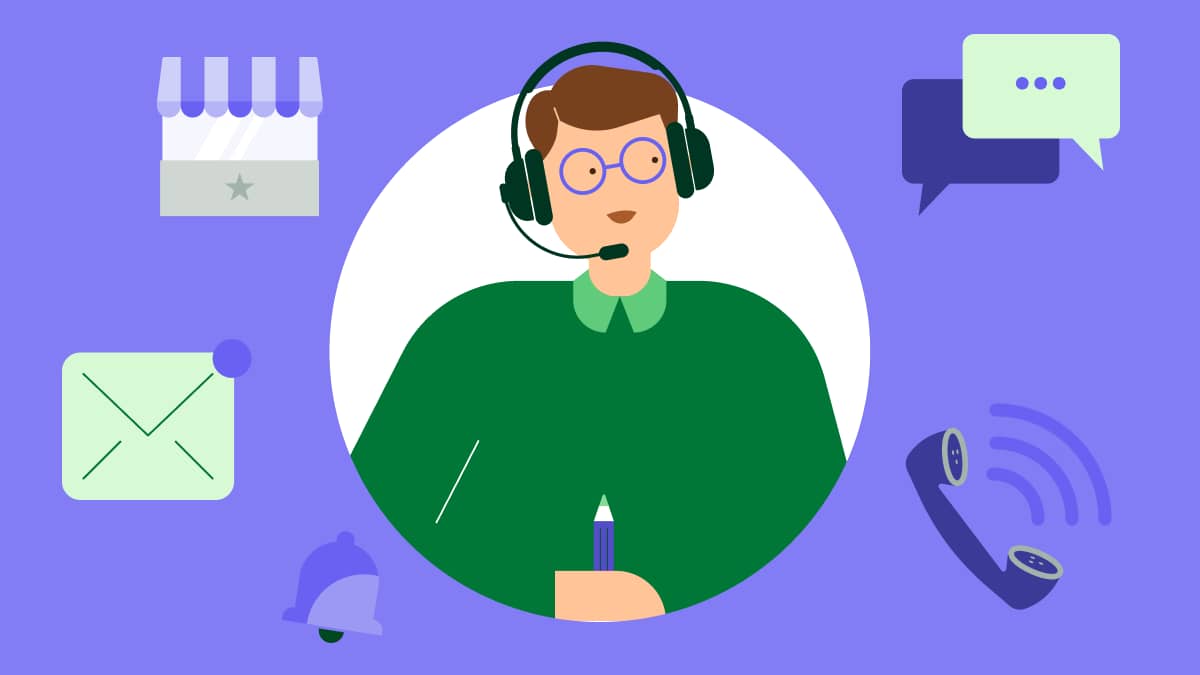Customer satisfaction matters in every industry. To keep up with the competition, brands must put more resources than ever into building and maintaining strong customer relationships.
But how can you go that extra mile to delight the customer? And how do you do it at scale?
In this article, we explore what customer delight is and why it matters. We’ll also look at ways to delight your customers, examples of companies doing it well, and methods to measure it.
What is customer delight?
Customer delight refers to the pleasure or joy a customer experiences when interacting with your brand, product or service. It goes beyond customer satisfaction; delighted customers leave the experience feeling happy, pleasantly surprised and relieved.
Researchers often describe customer delight in terms of three characteristics:
Customers experience a positive feeling
Customers feel like the brand exceeded their expectations
Customers feel positively surprised
These components can come from a high-quality product, superior service or some other aspect of the customer experience that exceeds expectations.
Customer delight is an intentional outcome. It results from a well-designed product, thoughtful customer relations activities and well-trained support staff.
Customer delight vs. customer satisfaction
Customer delight and customer satisfaction refer to different levels of positive experience and emotional response to a product, service or brand.
Customer satisfaction occurs when you meet customer expectations. It’s a baseline measure indicating the product or service was good enough.
Customer delight involves exceeding customer expectations and creating a memorable experience beyond satisfying needs. Delight occurs when a customer’s interaction with your business provides pleasure or joy.
Why does customer delight matter?
Delighting the customer matters because it directly impacts your company’s reputation, customer base growth and revenue.
Customer satisfaction researchers found that “delighting customers” is an important strategy for building competitive advantage through customer loyalty.
Here are some specific benefits happy customers can bring to your business.
Enhanced customer loyalty: Research suggests that delighting customers increases brand loyalty and customer retention, even more so than customer satisfaction. Delighted customers are more likely to make repeat purchases or continue their subscription to your services.
Increased customer lifetime value (CLV/LTV): When happy customers are more loyal, they will likely spend more on your products or services.
Testimonials and reviews: Delighted customers feel strongly connected with your brand and are more willing to become brand advocates. They may provide testimonials, customer stories and positive reviews that you can use as social proof and marketing collateral.
Word-of-mouth marketing and referrals: Happy customers share their positive experiences and recommend the business to others. Sales referrals can help you generate more leads, prospects and closed deals.
Each of these benefits can contribute to increased business success and growth.
10 ways to delight your customers
To delight the customer, you need to exceed their expectations consistently. That sounds difficult, but there are some concrete strategies you can use to accomplish this goal.
Here are some of the best ways to provide outstanding customer experiences.
1. Excellent customer support
Customer support is critical in delighting customers and contributes to the overall customer experience.
Gartner found that customers who received high-quality service – extra value during a service interaction, more than just a resolution to their problem – were 82% more likely to stay with a company when offered a chance to switch to a competitor.

Start with responsiveness, work to provide near-instant response time to customer problems, then work quickly to resolve problems. Provide a refund, offer a discount or even send a handwritten apology note, without making customers jump through hoops.
Going above and beyond in customer support can help you turn a negative experience into a positive one and create a loyal customer for life.
Customer relationship management (CRM) software can help you manage your customer interactions and respond quickly.
For example, Pipedrive offers a chatbot that instantly assists your website visitors. It resolves issues faster by providing answers to common questions. If needed, it can notify a sales or customer service team member through live chat to provide a personal touch.

Pipedrive’s Chatbot and Live Chat features are available in the LeadBooster add-on.
2. Make it easy to contact your company
Help your customers get support when they need it and get it fast. The average person hangs up after less than two minutes of hold time and 34% of those who hang up won’t call back.
One way to avoid these issues is to clarify where customers can find support. Offering different options and channels is an easy way to delight the customer.
For example, consider offering multiple ways to contact you, like email, phone, web chat, social media, web forms or messaging apps like WhatsApp. Customers can then choose the channel they are most comfortable with.
Self-service options can also enhance customer experience because many people prefer solving problems themselves. Providing a comprehensive Frequently Asked Questions (FAQ) section, help center or community forums on your website can allow customers to find answers without contacting support directly.
3. Provide after-sales service
After-sales service is the support you provide after a customer buys your product or service. It includes warranties, technical support, product installation, maintenance, repairs and even taking customer feedback for future improvements.
Great after-sales service helps your customers get the most value from your product. It can delight customers too.
For example, you can send post-sales training resources to teach customers how to get the most from your products’ features. Pipedrive does this through an Academy that’s accessible to every Pipedrive user. It shows you how to use Pipedrive features and offers training on best practices for customer sales agents, marketers, customer success managers and sales reps.
Here’s an example video of our email marketing software: Campaigns.
4. Act on the feedback your customers give you
Customer feedback gives you insight into what your customers think about your product or service so you can improve. By acting on that feedback, you can deliver better products and services, enhancing the overall customer experience.
More than that, it shows you’re listening. When you engage with customer feedback, you demonstrate respect for your customers. You foster trust and loyalty.
You can ask for feedback in several ways – with surveys, on your app or via email. Like this email from Arc to its subscribers.

Remember to follow up with your customers after you act on their feedback. For example, if a customer asks you to build a new feature, let them know when the project is underway. Closing the feedback loop helps you get credit for listening to your customers.
5. Offer personalized experiences
Personalization means tailoring your products, services or messaging to meet the individual needs and preferences of each customer. Done well, personalization creates a unique and unforgettable customer experience.
Personalization could include addressing customers by name, offering customized products or services or providing personalized recommendations. By personalizing your customer's experience, you can make them feel valued.
The trick to personalization is doing it at scale. That’s where artificial intelligence (AI) and automation can be extremely valuable. Here are some examples:
Analyze the sales data in your CRM database to understand each customer’s preferences. Then create recommendation models to suggest products and services they’ll find valuable.
Use the same data to predict when a customer is most likely to make another purchase from you. Then send an automated email campaign offering a discount or special offer.
Employ behavior analysis to identify users who may not be getting the most value from your products or services. Then reach out to them and offer your resources to help them benefit more from your product or service.
AI and automation let you provide personalized experiences to thousands or hundreds of thousands of customers. That level of personalization can enhance customer satisfaction and delight.
6. Gifts
A quick way to build customer delight is to offer a gift. Gifts make customers feel appreciated and valued. They show you care about them and are willing to go above and beyond to make them happy.
Receiving something free also increases the perceived value of your product. Your customers will feel like they’re getting more than they paid for.
As a bonus, your customers may feel like they need to return the favor. Gifts can prompt customers to reciprocate by leaving positive reviews, providing testimonials or recommending your company to others.
The element of surprise is critical to customer delight. Consider going beyond a gift on a special occasion or birthday to maximize delight. Offer gifts at unexpected times, like the six-month anniversary of signing up with your brand, or the anniversary of your customer’s third purchase.
7. Loyalty programs
Customer loyalty programs are structured marketing strategies to incentivize and reward repeat customers. They often offer members points, rewards or discounts based on their purchases or engagements with the company.
But loyalty programs are about more than points. Some offer bonus perks that contribute to a positive overall buying experience, like expedited shipping, priority customer service or easy returns.
Others offer exclusive deals, early access to products or special events. They provide a sense of exclusivity that makes customers feel special and valued.
All those features contribute to delighting customers.
Consider structuring your loyalty programs like a game where customers earn points or achieve milestones. Enhance the customer’s interaction with the brand, making it more enjoyable.
8. Invitations for free product tests
Launching a new product or feature? Consider inviting engaged customers to help you test it.
The strategy has many benefits. First, test products are like gifts. For the customer, it feels exciting to try a product or feature before it launches.
Second, selecting a customer for product testing – an opportunity not available to everyone – makes them feel special and valued.
For example, UsabilityHub included this offer to join its beta testing group in an email newsletter.

And Pipedrive does it in our Research and Beta Testing forum.

When conducting product tests with customers, make the process as easy and enjoyable as possible for them and consider their feedback. Show respect for their time and opinions, thereby enhancing their delight.
9. Invitation to a private group
Offer select customers access to a private community or VIP group with your brand. It could be a group that gets together in person or on social media.
For example, cloud service provider Fastly connects with enterprise customers through dedicated Slack channels, including a “situation room” channel to prepare for client events.
The exclusive nature of a group can help boost customer delight on its own, but being part of a group also creates a sense of community and belonging. Members can connect with like-minded people, share experiences and foster relationships, all of which enhance their satisfaction and connection to your brand.
Connect your private group to your loyalty program. That way, you reward and recognize your customers’ loyalty. An invitation to the group shows you value members’ engagement with your brand.
10. Build a community
Build a community around your brand by bringing engaged customers together and creating a space for them to communicate. You can do that through online forums, social media, in-person events or a combination.
A well-nurtured community can generate customer delight by providing a sense of belonging. It allows customers to build relationships with others, which enhances their emotional connection to your brand.
Communities can also allow customers to help each other by sharing experiences, advice or solutions. For example, your customers can help each other resolve problems before they need to contact your customer support team, as the below image from the Adobe community shows.

The result is increased customer satisfaction. It can even help potential customers see the positive customer experiences others are having with your product, encouraging them to convert.
We encourage customers to connect and share experiences in our Pipedrive Community:

Here, users can communicate with each other about all things CRM, see upcoming updates and get advice on industry matters.
Customer delight examples
Many companies use customer delight as a key differentiator from competitors. They recognize that creating positive emotional experiences can foster loyalty, generate positive word-of-mouth and drive business growth.
Here are some companies that are standout examples of this customer-first approach.
JetBlue
JetBlue’s founder wanted to create an airline that excelled at customer service. Several examples show how it’s lived up to that vision:
The company used studies and surveys to inform pricing changes. It created different pricing options so customers could find prices that suit their needs.
Customer feedback indicated passengers were disappointed that airport shops and amenities weren’t open for early flights. JetBlue responded by offering customers water, juice and coffee at the gate on those flights.
JetBlue goes above and beyond with customer support by making it easy to get credits or refunds for canceled flights.
The company offers gifts to customers regularly to compensate for any inconvenience. For example, they offered free movies on flights to make up for weather delays.
These actions show that delighting the customer is a consistent priority for JetBlue.
How to delight your customers like JetBlue: You can apply the same strategies JetBlue uses by investing in surveys to understand your customer needs, implementing feedback and creating great customer service.
Canva
Canva is an online design and publishing tool with a mission to empower everyone to design anything and publish anywhere. It takes a product-first approach to growth, focusing on creating a superior product experience that delivers value quickly.
Canva also invests in its community. There are over one million people in Canva communities worldwide and the company attributes much of its growth to the word-of-mouth marketing that happens through these communities.
Finally, Canva has a great social media strategy. It provides personalized responses on social media to customers, complete with beautiful personalized images.

How to delight your customers like Canva: Ensure your product offers a fantastic user experience. Then consider creating a thriving customer community and providing quick, personalized responses on social media.
When I Work
Scheduling software When I Work delights customers with several customer service initiatives. For example:
It sends T-shirts and other gifts to its top customers
It sends candy bars to customers with problems so they have the “sweetest” possible experience
It sends every new customer a handwritten thank-you note
Some customers share those notes on social media, creating free word-of-mouth advertising for the company.

How to delight your customers like When I Work: Consider sending handwritten notes. It’s a strategy that doesn’t scale easily, but it can be effective even if you only use it for some key customers.
Sephora
Sephora became a giant in the cosmetics space in part due to its successful customer experience formula.
One of its most successful strategies is providing customers with a seamless online or in-store experience. The company aims to eliminate friction and make purchasing simple.
Sephora also uses technology to provide personalized shopping experiences. For example, it offers a skin scanner to show clients their ideal shade for foundation and other makeup items. It also sends members a gift on their birthday.

Finally, Sephora uses in-person shopping experiences to offer expert advice for products and application techniques. Customer service staff add value for customers who might otherwise buy online.
How to delight your customers like Sephora: Sephora excels at using technology to create personalized experiences, so you can do the same. For example, you might use personalized images or personalized emails to send the right messages to the right customer at the right time.
How to measure customer delight
You can measure customer delight similarly to other indicators of customer sentiment like customer satisfaction or customer experience.
Here are a few ways to measure customer delight.
Net promoter score
Net promoter score (NPS) is a single-item measure that tells you how likely a customer is to promote your brand and recommend it to others.
NPS is usually measured with a question like “On a scale of 0 to 10, how likely are you to recommend our business to a friend or colleague?” Customers who answer with a 9 or 10 are promoters who are likely delighted by your product or service.
Customer satisfaction score (CSAT)
Customer satisfaction score (CSAT) is another simple measure that shows if a product meets or exceeds your customers’ expectations. You can measure it with a question like “How satisfied are you with [Product/Service]?”
CSAT scores tell how satisfied customers are with your product, service or brand. While satisfaction and delight aren’t the same, a high satisfaction score indicates customer delight.
Customer churn and retention rate
Churn rate is a customer success metric calculated by taking the number of customers who stop using a product or service over a given period and dividing that figure by the remaining number of customers. It’s often used in subscription-based businesses.
Delighted customers are more likely to stick with a product or service and less likely to churn. Lower churn rates, therefore, indicate higher customer delight.
Sentiment analysis
Sentiment analysis involves analyzing customer feedback to determine the emotional tone or sentiment behind words used in text. Companies use it to understand attitudes, opinions and emotions from written language.
For example, you could analyze the sentiment on your online reviews, survey responses or customer service chat logs to learn how your customers feel about your product. More positive sentiment indicates higher customer delight.
Final thoughts
Creating customer delight means exceeding a customer’s expectations, forging a positive emotional connection with your brand and adding an element of surprise.
The trick is figuring out how to do it at scale and systematizing it across the customer’s journey.
A CRM tool can help. Your CRM holds the data you need to understand what your customers like. A quality CRM will ensure your customer support systems are solid and you can personalize your approach to each customer.
Learn more about how Pipedrive can delight customers across your pipeline.













